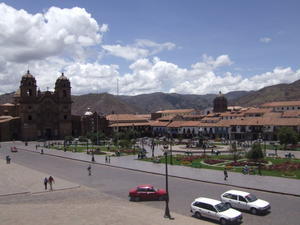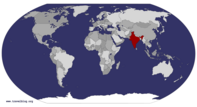Advertisement
Published: March 10th 2007

 Cusco
Cusco
The calm before the street sellers emergeWe finally dragged ourselves from the hammocks in Copacabana and made our way to Peru, where we were looking forward to visiting Cusco the ancient seat of the Inca empire and making the 4 day trek to the lost city of Machu Picchu.
We hopped onto the full-to-bursting "Copacabana-Cusco 14 hour Express" early on a sunny afternoon. It was more a mobile clothes shop than bus - huge amounts of warm winter jackets and boxes of the latest running shoes were stuffed into every nook and cranny. Seems like there was a little bit of smuggling going on along the Bolivian-Peru border! 13 hours later and having sat through 4 Dolph Lundgren films (never know why he didn't make it big) we were coming close to Cusco city when we were pulled over by the fiscal police. Widespread pandemonium overtook the bus. People were frantically pulling on 2 and 3 jackets and putting on the runners. When the fiscal police made it onto the bus it must of made an impressive sight - it was 30 C outside in the tropical night air yet everybody was wearing at least one winter jacket and old men were sporting the latest Nike
Air. They hauled off a few people and confiscated a few jackets and shoes amid much feigned hysteria from the other passengers (whom I reckon were secretly happy that they're own goods were not confiscated). Outside and with the exchange of some words (and some dollars) the merchandise was brought back on board and off we headed again.
We finally made it to Cusco. It is a small city, easy to get around and proud of its cultural heritage as the ancient seat of the Inca Empire. The Inca Empire only lasted about 100 years (around the years 1450-1550) at its peak before they were conquered and wiped out by the Spanish. As a result there is little or no gold left (most of it taken to Spain and Europe) and the wiping out of most of the Inca race means that the history is somewhat veiled. Still there are enough sites to give any visitor a good flavour of what life was like for the race that controlled a large chunk of South America at its peak.
Cusco and Machu Picchu is one of the most visited cities in the Americas and you quickly realise how touristy
it is. Stand still for a moment you are swarmed (and I really mean swarmed!) by adults and small children alike as they try to sell there wares...we were offered everything from postcards to "genuine" Inca treasure to baby llamas. Stand in one place long enough and you're likely to be offered small firearms and the secret of the Holy Grail. But you had to admire their sheer persistence and dedication to getting a sale. After all this is a place where you could even buy "NO GRACIAS" t-shirts to help you stave off the street sellers!!
We spent the time before the Inca trail exploring the other Inca sites around the Cusco countryside (and avoiding the street sellers) and finding out a little about the Incas. Not only content with being the first producers of potatoes and having a staggering 1,000 varieties, they also bred guinea pigs to a huge size for their meat. Today they are still bred (we visited a really weird guinea pig farm), though they are normal size, and still killed for their meat. And so today you can find oven baked Guinea Pig on most of the restaurant menus in Cusco...tasty!!
But
we hadn't come to try the Guinea Pig; it is the Inca trail and the lost city of Machu Picchu that makes the trip to Cusco worth it. The lost city was only discovered in 1911 by an American professor/explorer having remained hidden (from Western eyes anyway) for 400 years. It seems that the Spanish never discovered the city in their conquest and as a result it remained in pristine condition. The track itself is a long meandering trek with lots of look out towers and fortresses along the way. Much of the trek is still in its original form and you can imagine how it was easily concealed within the forest that surrounds it. Seems that the Peruvian government is now trying to get back the artifacts taken by the 1911 expedition and subsequent expeditions. So it seems that Inca sites got sacked a second time.
It was a good physical 4 day hike, especially on the second day (over a place called "Dead Woman's Pass" at a height of 4,215 meters, nearly as high as Mt Blanc), but a really enjoyable one through forest. The hike is now a regulated hike by the Peruvian government so you

 Machu Picchu
Machu Picchu
Worth the 4 day hike - pity about the fogneed to go in a group led by a guide. Also porters are provided to carry the tents and cooking gear for the group. And so despite climbing to great heights and trekking for 4 days the feeling that you are a famous explorer quickly disappears everytime you need to shuffle out of the way of these porters jogging past you with no more than sandals on their feet and about half their body weight on their backs!!
On the last morning you get up a couple of hours before dawn so you can hike the final leg of the journey and approach Machu Picchu at the break of dawn. You get a great sense of satisfaction as you reach the final pass and make your way down into the city. Despite a good deal of fog we had a good time exploring the city before the "tourists" arrive from the other side of the mountain where a train and a bus can carry you in comfort without doing the 4 day trip. After a few hours of wandering around we decided that we had been all "Inca-ed" out and it was time to head back to Cusco (by
train and bus of course!!)
After a good dinner of Guinea Pig and potatoes on our return it was time to leave Cuzco and head up the coast of Peru. We took a bus to Nazca to see the famous Nazca lines. Strangely, we were video taped by some guy in a bullet proof vest as we boarded the bus to Nazca, just in case the bus fell over the side (you gotta' see the steep valleys the buses cross!) or held up by bandits. The Nazca lines were drawn about 2,000 years ago and are basically large etchings in the ground. You can only see the Nazca lines in any coherent way from the skies and presuming that the Nazca people could not fly there has been much speculation about as to how they were drawn and by who - many see them as extra terrestial drawings. So the real attraction lies in wondering not only why they were drawn but how they could have been drawn 2,000 years ago with such precision. We took a small 4 seater plane up to see them. There are loads of individual figures across a range of a few miles, ranging

 Humming Bird Etching in Nazca
Humming Bird Etching in Nazca
Check out how precise the drawing is!!from simple lines (UFO landing strips??!!) to hummingbirds, monkeys, and even a "spaceman"!! The precision is impressive and you do wonder how they were drawn but I must admit that short of meeting ET I remain a sceptic on the aliens theory.
After leaving Nazca, we wound our way along the coast towards the capital Lima. One of the more interesting towns we stopped at was the small oasis of Huacachina. Located in the middle of a small desert it was a great place to hang out for a few days and go sandboarding. We took a jeep out into the sand dunes and with our greased plywood boards (nothing fancy out here and not a health and safety officer to be seen for miles) we jumped off the dunes into the valleys below (check out the video clip at the top of the page). Huacachina was also the site of one of my strangest bar experiences ever. I sat up to the counter at the bar in our hostel. A huge, surly barman sat on a high stool behind the bar, a barmaid sitting beside him. I ordered a cold beer and the barman landed it in front

 Spaceman
Spaceman
Spaceman etching in Nazca - I'm still not convincedof me without a word and without moving from his seat. Then he threw his bare feet into the lap of the barmaid who produced nail clippers and proceeded to cut his nails. After picking my jaw up from the floor, I finished my beer and made for the door avoiding the flying shrapnel.
And finally we made our way to Lima, the capital of Peru to spend our last few days in South America. Not wanting to be too unkind but Lima has all the charm of a petrol station forecourt. It had none of the allure of the other cities we visited on our travels and despite spending a few days walking around trying to soak up the atmosphere we just felt as if everyone was waiting to rip you off - from kids in shops to taxi drivers. We had heard that Lima is not particularly fond of gringos and after a few days we were inclined to believe it to be true. There was however the Gold Museum, the biggest collection of Inca gold treasures still remaining in South America which was impressive.
And so ends our South American adventure for now.
Next

 Dune Buggying
Dune Buggying
Marie corners sharply while I model the latest in Sandboarding eyewearstop Australia.
Dave
Advertisement
Tot: 0.267s; Tpl: 0.014s; cc: 10; qc: 29; dbt: 0.0206s; 1; m:domysql w:travelblog (10.17.0.13); sld: 1;
; mem: 1.1mb









